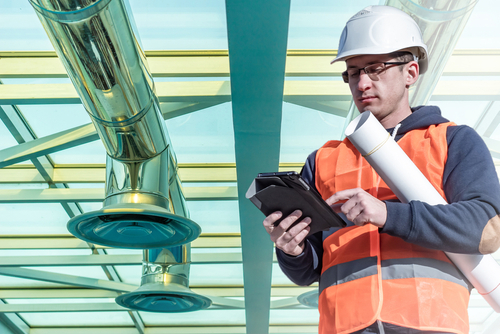As environmental consciousness grows, carbon footprints have become a critical concern for businesses across various industries. In particular, commercial buildings account for a significant portion of greenhouse gas emissions due to their energy-intensive operations, with heating, ventilation, and air conditioning (HVAC) systems playing a substantial role.

In this article, we will explore 10 effective strategies to help reduce the HVAC carbon footprint in your commercial building, thereby paving the way for a greener and more sustainable future.
1. Energy-Efficient HVAC Systems
Investing in energy-efficient HVAC systems is a fundamental step toward reducing carbon emissions. Upgrading your current system to one that utilizes advanced technologies, such as variable refrigerant flow (VRF) systems, high-efficiency heat pumps, or geothermal heat pumps, can significantly enhance energy efficiency. These systems optimize heating and cooling processes, leading to substantial energy savings and a reduced carbon footprint.
2. Regular Maintenance and System Optimization
Regular HVAC system maintenance and optimization are vital for optimal performance and energy efficiency. Schedule routine inspections, cleanings, and tune-ups to ensure that your system operates at its peak efficiency. Regularly replace air filters, check refrigerant levels, and calibrate thermostats to maximize energy savings. By promptly addressing maintenance needs, you can prevent potential issues, minimize energy waste, and reduce carbon emissions.
3. Smart HVAC Controls and Building Automation Systems
Implementing smart HVAC controls and building automation systems can revolutionize energy management in commercial buildings. These advanced technologies provide centralized control over various building systems, including HVAC, lighting, and security. These systems optimize energy consumption based on occupancy patterns and environmental conditions by leveraging sensors, data analytics, and intelligent algorithms. This results in significant energy savings, improved comfort levels, and a reduced carbon footprint.
4. Occupancy Sensors and Zoning Strategies
Integrating occupancy sensors and employing zoning strategies are effective methods for minimizing energy waste and reducing the HVAC carbon footprint. Occupancy sensors detect activity within specific building areas and adjust HVAC settings accordingly, ensuring energy is only consumed when needed. Zoning strategies divide the building into separate areas with independent temperature controls, allowing you to optimize heating and cooling based on occupancy and usage patterns. You can achieve substantial energy savings and environmental benefits by targeting conditioned air only where necessary.
5. Renewable Energy Integration
Embracing renewable energy sources is a crucial aspect of reducing the carbon footprint of commercial buildings. Consider incorporating solar panels, wind turbines, or geothermal systems to generate clean energy on-site. These renewable energy solutions can supplement the energy requirements of your HVAC systems, reducing your reliance on fossil fuels and decreasing carbon emissions. Additionally, you can explore opportunities for net metering or feed-in tariff programs, enabling you to sell excess renewable energy back to the grid.
6. Building Envelope Enhancements
Improving the building envelope is a valuable strategy to enhance energy efficiency and reduce HVAC-related carbon emissions. Enhancements may include upgrading insulation, sealing air leaks, and installing energy-efficient windows. These measures minimize heat transfer, regulate indoor temperatures, and reduce the workload on HVAC systems. By effectively sealing the building envelope, you can prevent energy losses, achieve better indoor comfort, and contribute to a greener environment.
7. Employee Engagement and Awareness
Raising employee awareness about energy conservation and sustainability can significantly impact the carbon footprint of your commercial building. Encourage employees to adopt energy-saving practices, such as turning off lights when not in use, utilizing natural light, and shutting down computers during non-working hours. Educate your workforce about the importance of reducing carbon emissions and the positive environmental impact of their actions. By fostering a culture of sustainability and empowering employees to make eco-conscious choices, you can create a collective effort toward reducing your HVAC carbon footprint.
8. Monitoring and Data Analysis
Implementing an advanced energy monitoring and data analysis system allows you to gain valuable insights into your HVAC system’s performance and energy consumption patterns. By collecting and analyzing data on energy usage, you can identify areas of improvement, detect anomalies, and make data-driven decisions to optimize energy efficiency. Real-time monitoring and analysis enable you to proactively address energy inefficiencies, leading to significant reductions in carbon emissions.
9. Collaboration with HVAC Professionals
Engaging with experienced HVAC professionals and sustainability experts can provide valuable guidance and support in reducing your carbon footprint. These professionals can conduct energy audits, assess your HVAC system’s efficiency, and recommend tailored strategies to enhance sustainability. Collaborating with experts in the field ensures that you have access to the latest industry knowledge and best practices, facilitating effective carbon reduction initiatives.
10. Ongoing Evaluation and Continuous Improvement
Reducing the HVAC carbon footprint is an ongoing process that requires continuous evaluation and improvement. Regularly assess the effectiveness of your sustainability initiatives, monitor energy consumption, and track carbon emissions. Identify areas where further improvements can be made, and implement additional measures accordingly. You can continuously enhance your commercial building’s environmental performance by constantly striving for progress and embracing innovative solutions.
Bottom Line
Reducing the HVAC carbon footprint in commercial buildings is an environmental responsibility and a strategic decision that can positively impact your bottom line. You can significantly reduce carbon emissions while optimizing energy efficiency by implementing energy-efficient HVAC systems, conducting regular maintenance, adopting smart controls, integrating renewable energy sources, and engaging employees. Embracing sustainable practices positions your business as a responsible environmental steward and helps you stay ahead in an increasingly eco-conscious market.
Walter E. Bennett is a skilled handyman who has devoted his career to providing exceptional services for Green Leaf Air. With a specialization in heating and cooling unit installation, repair, and maintenance, as well as duct cleaning, plumbing, and various home improvement projects, Bennett has become a trusted professional throughout Texas.
